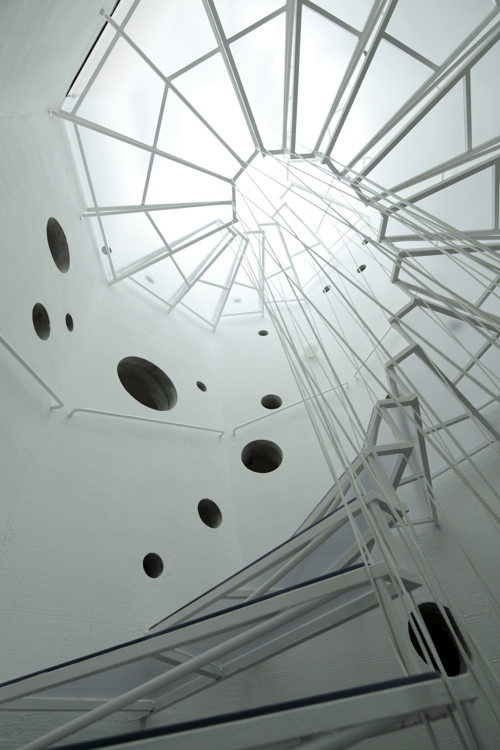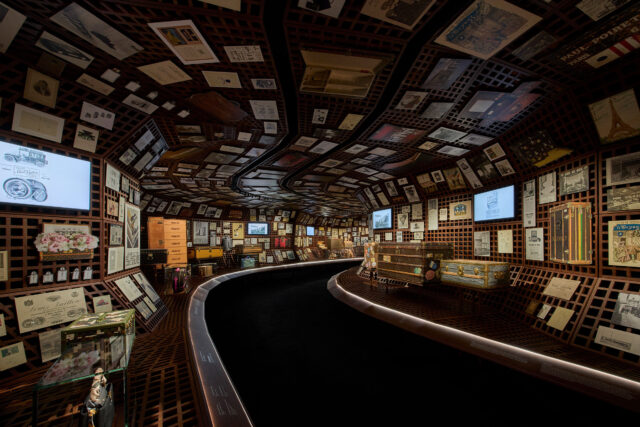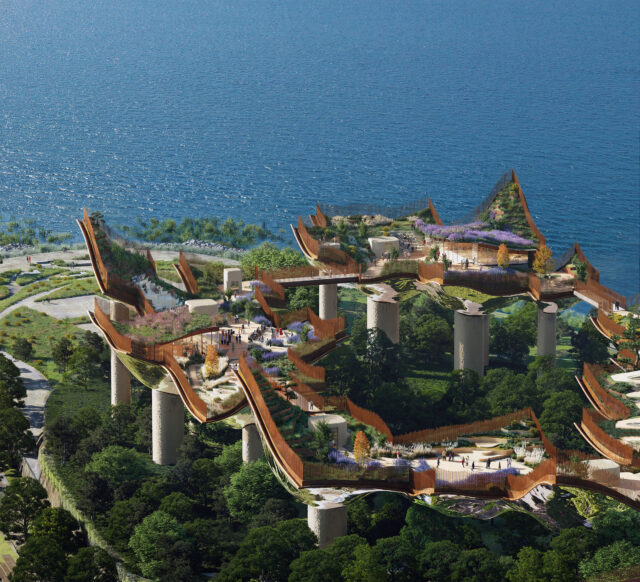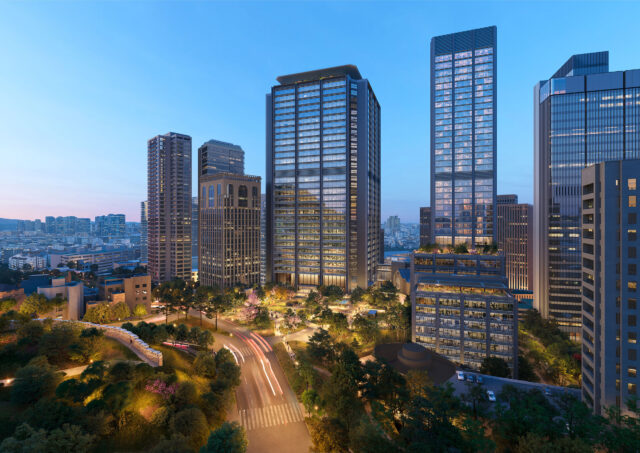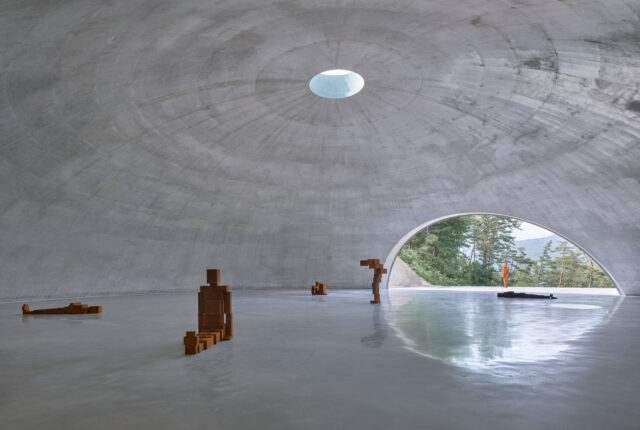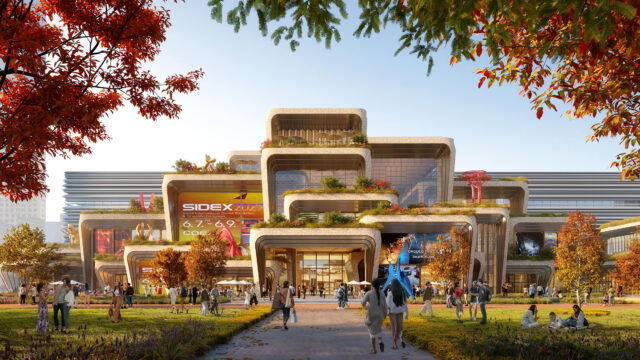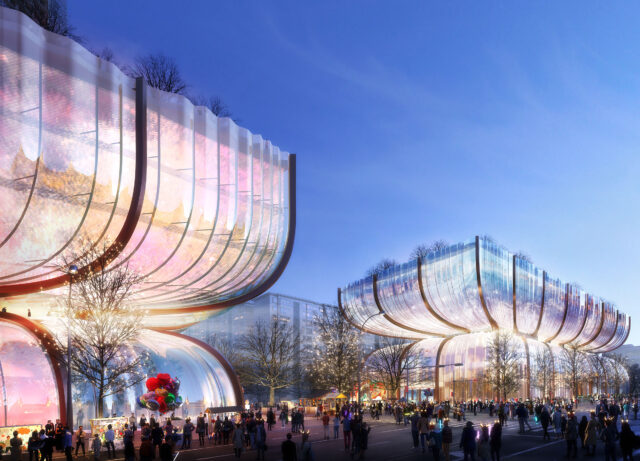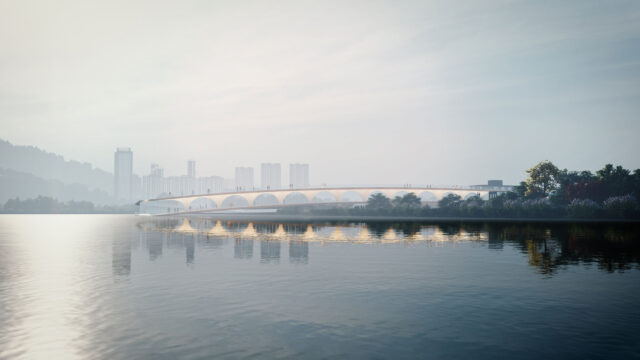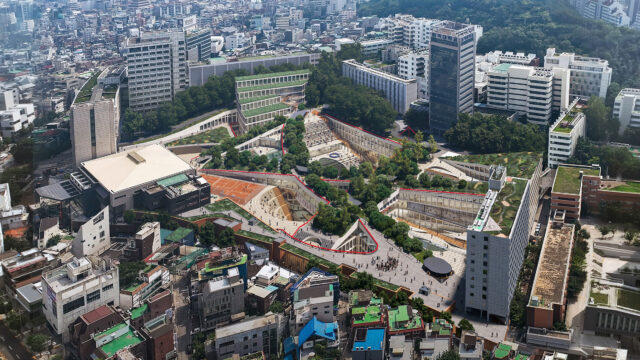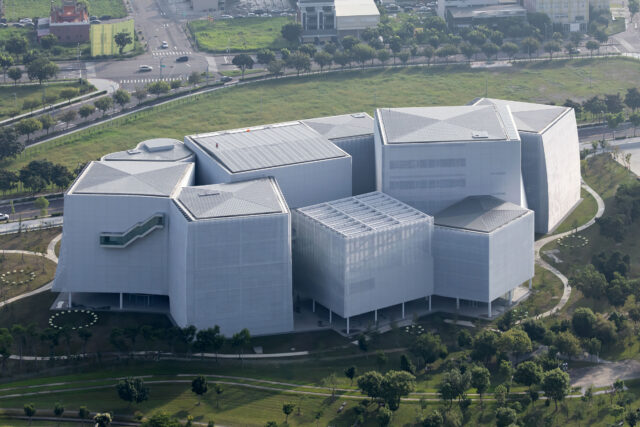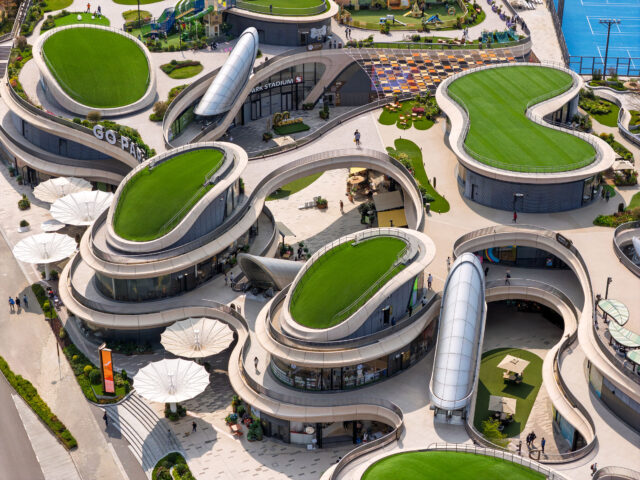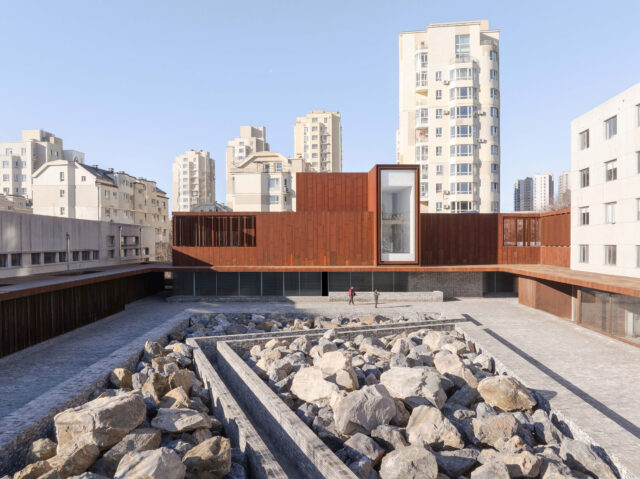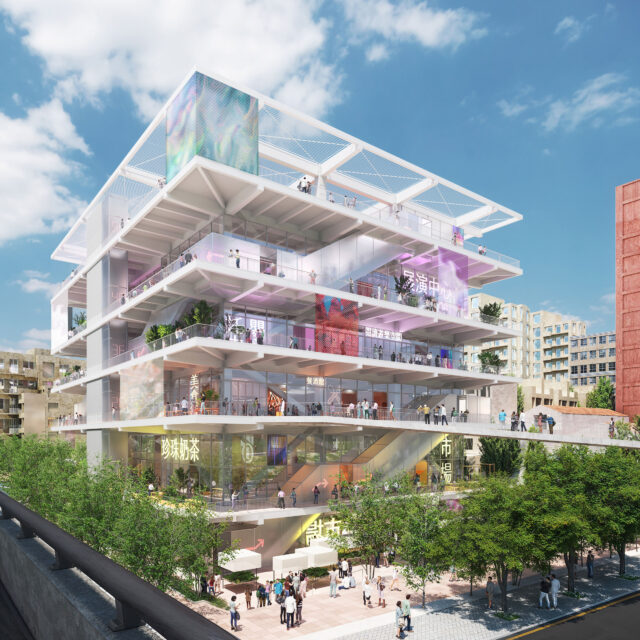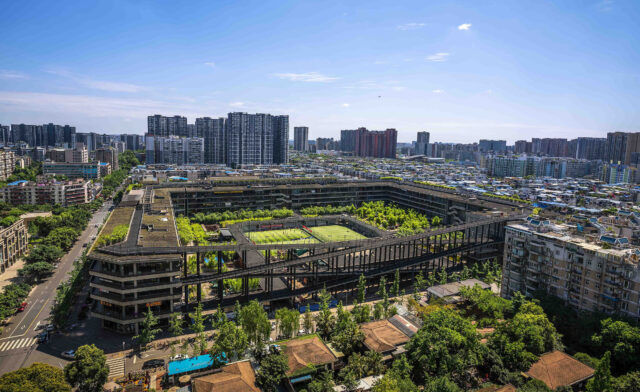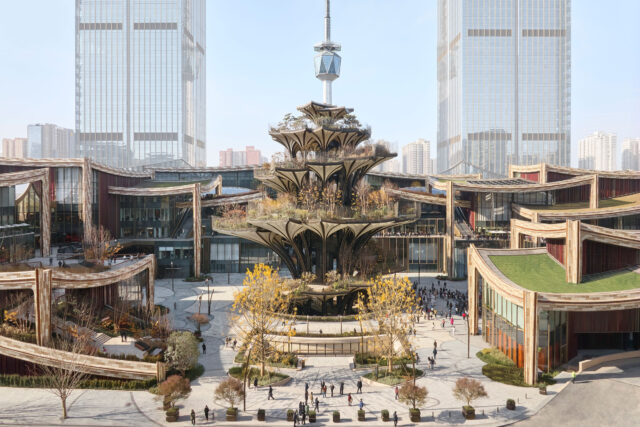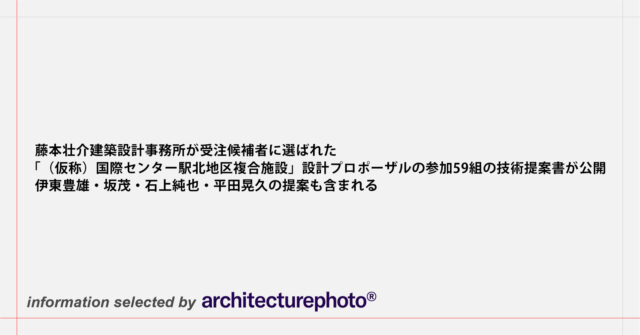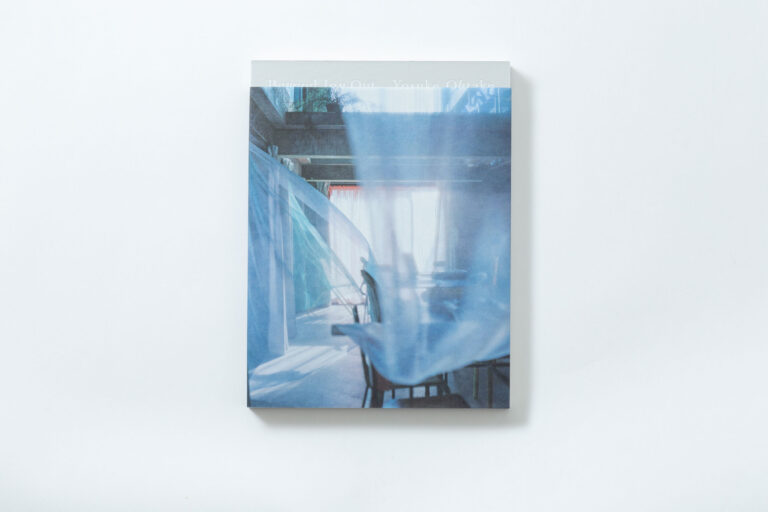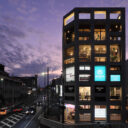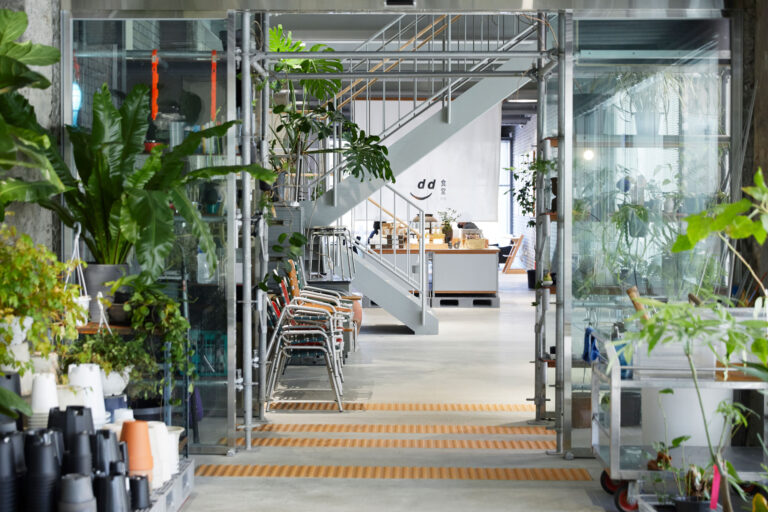
SHARE 長坂常 / スキーマ建築計画による、韓国・済州島の、既存建物二棟を改修した宿泊・物販・飲食等の機能を持つ施設「D&DEPARTMENT JEJU by ARARIO」。“見えない開発”の中で完成した建築のひとつ



長坂常 / スキーマ建築計画による、韓国・済州島の、既存建物二棟を改修した宿泊・物販・飲食等の機能を持つ施設「D&DEPARTMENT JEJU by ARARIO」です。長坂が「見えない開発」と呼び進めている済州島塔洞での街全体の開発プロジェクトのひとつとして完成したものです(※「見えない開発」については下部のテキストを参照)。施設の公式サイトはこちら。
このD&DEPARTMENT JEJU by ARARIOはD&DEPARTMENTの中でも最大で、食堂、ストア、ギャラリーに新たな機能として宿泊機能を満たすd roomとあらゆる職人、アーティスト、デザイナーなどが泊りながらワークショップできるようにキッチン+ギャラリー+寝床を備えたd newsというものが入る。
d newsは今まで数時間に限定して行っていたワークショップを数日に渡り行えるように宿泊施設を併設したワークショップスペースでより深くロングライフデザインを語り合う場所となる。
また、来るアーティストにとってもただ教えに来るだけではなく、長期滞在する中で新たな材料などに巡り合い新たな創作活動のきっかけを得ることになる。そんな双方向の文化交流地点として計画した。「ホテルのようなもの」でd roomというものがあり、ストアの延長にあり、本来ホテルというものは東西に細長く中廊下を介して南北に部屋が効率よく並ぶものだが、この建物は四角に近いことから、どの部屋も窓を設け外に接しようとするとそれぞれ中に空洞が生まれ、同時にそのために作られた開口部ではないことから各部屋に歪みが生じ一つとて同じ間取りにならない。それによって、各部屋の間取りが異なり、その暗い空洞部にトップライトをとり光を入れホテルの共用部のようなストアができた。
共用部も個室も室内にある全てのモノ、例えば家具や植物、雑貨に到るまでが全て商品で宿泊することでじっくりロングライフデザインを堪能しショッピングを楽しむ場所となる。
以下の写真はクリックで拡大します































































以下、建築家によるテキストです。
このD&DEPARTMENT JEJU by ARARIOはD&DEPARTMENTの中でも最大で、食堂、ストア、ギャラリーに新たな機能として宿泊機能を満たすd roomとあらゆる職人、アーティスト、デザイナーなどが泊りながらワークショップできるようにキッチン+ギャラリー+寝床を備えたd newsというものが入る。
d newsは今まで数時間に限定して行っていたワークショップを数日に渡り行えるように宿泊施設を併設したワークショップスペースでより深くロングライフデザインを語り合う場所となる。
また、来るアーティストにとってもただ教えに来るだけではなく、長期滞在する中で新たな材料などに巡り合い新たな創作活動のきっかけを得ることになる。そんな双方向の文化交流地点として計画した。
「ホテルのようなもの」でd roomというものがあり、ストアの延長にあり、本来ホテルというものは東西に細長く中廊下を介して南北に部屋が効率よく並ぶものだが、この建物は四角に近いことから、どの部屋も窓を設け外に接しようとするとそれぞれ中に空洞が生まれ、同時にそのために作られた開口部ではないことから各部屋に歪みが生じ一つとて同じ間取りにならない。それによって、各部屋の間取りが異なり、その暗い空洞部にトップライトをとり光を入れホテルの共用部のようなストアができた。
共用部も個室も室内にある全てのモノ、例えば家具や植物、雑貨に到るまでが全て商品で宿泊することでじっくりロングライフデザインを堪能しショッピングを楽しむ場所となる。
また、そもそもUSEDを多く取り扱うこのd roomの家具が売り物となるとホテルとしても行くたびに代わりたとえ同じ部屋でも異なる感覚を味わえる。インテリアとしてはホテルではありえないほどに大きく窓が開き、そして各部屋各々異なる装いになっていた。
そして、これだけの機能を満たす面積を確保するのに、1棟では足りず、2棟を合体し作った。また、D&DEPARTMENTではないが本建物の植栽を一手に引き受けるpadosikmulの活動の場としてピロティとその2棟の間の隙間に足場を立てて生息する。その植栽はどれも商品ゆえ、季節の変化の他に商品入れ替えによって絶えず動き、変化し続ける。
■建築概要
題名:D&DEPARTMENT JEJU by ARARIO
設計:長坂常/スキーマ建築計画
担当:宮下翔多
所在地:3 Tapdong-ro 2-gil, Jeju-si, Jeju-do Korea
主用途:飲食、ギャラリー、物販、ホテル
施工:Yigak
協力:
ディアンドデパートメント株式会社(プロデュース)
ARARIO JEJU(運営)
MILLIMETER MILLIGRAM(プロジェクトマネージメント)
PADOSIKMUL(植物計画)
TOPEC(ローカルアーキテクト)
階数:3階
床面積:2327㎡(1F d食堂:232㎡ ギャラリー:91㎡/2F ショップ:303㎡ dnews:98㎡/3F d room:789㎡)
構造:鉄骨造、RC造
竣工:2020年5月
写真:イジュヨン
見えない開発
済州島の北、Tapdong。この地域は1990年代に市場やショッピングスペース、映画館などが立ち並び、済州島最大の繁華街として栄えた。その後、繁華街が済州市の南側の新都市に移り、開発が進まず、徐々に廃れ、部分的には廃墟と化して全く人が立ち寄らなくなった。
その中心にあるArario Museum Tapdong Cinemaとなっている建物は昔その地域の中心的存在の映画館だった。そこが廃業し、その後、放置され荒れ果てていたところをARARIO創始者であり、アーティストでもあるキム・チャンイル会長が訪れた。
見に来た時にはあるべき鉄骨も盗まれたバブル期には流行っていた映画館を中心に荒れ放題の町だったという。でもそんな街に可能性を感じ、まずはその映画館跡地を買い、新築を建てるのではなく、改修し美術館にコンバートした。
当時は荒れ果てた場所ということもあって値段も安くその周辺をまとめて購入し、気づいたら飛び飛びだが近隣の建物を20軒近くを所有していた。飛び飛びゆえ、一掃し、巨大な複合施設を作る訳にもいかないし、そもそもその気はなく一つ一つそこまで刻み込まれた痕跡を生かしながら改修し、このタプトンという町を再生させたいと考えたのだ。
ただ、最初に来た頃全くこの街に歩いている人がいなく本当に大丈夫だろうか?と心配にはなっていた。
そして、我々日本でも古い建物はたくさんあるが、こんなにまとめて買って一つずつ手を入れていくのは意外に少ないのではないだろうか?そんな古い建物を生かしたまちづくりにARARIOは挑戦するのだが、そこでナガオカケンメイさんのロングライフデザインという考え方はどストライクで、D&DEPARTMENT SEOULを運営するMMMGを介し、ナガオカケンメイさんと出会い、このD&DEPARTMENT JEJU by ARARIOというプロジェクトが立ち上がり、ARARIO MUSEUMと同様このタプトンという町の中心的存在にすべく計画が始まった。
我々はそこで建築から内装まで設計に携わらせていただいた。
さらに、その延長で、同時ににFREITAG storeと済州島の全土を自転車でつなぐハブになるべく作られたレンタルバイク屋「PORTABLE」が入る一棟、それからARARIO MUSEUMの下にカフェcreammを計画した。その後、コロナ禍少しずつ計画に拘らせていただいてる。
ある意味、これも開発かもしれない。ただ、一棟の一貫したデザインを全うする新築の開発に対して、このバラバラな飛び地での開発をどう捉え攻略すべきか考えた。もちろん、1棟ずつバラバラにデザインしてもより予想のつかない街になって面白いかもしれない。でも、やはりどうせなら建物を横断した人の動きを生み賑わいのある街にしたいと考え一定の共通の考えを設定したいと考え、その中から「見えない開発」という言葉が生まれた。
近づいて中が見えてこないと変化に気づかない、中に入って面白さがわかるとその先のもう一棟の建物も同じように変化があるのではないか?と期待させる。そのために極力外壁は既存のままで、中身を変えていく。
その際、グランドフロアでつながりを生むべく出来るだけピロティスペースを確保し、ハンドリフターを使って自由に植物や家具、サイクルスタンドなどが動かせるインターフェースという可動システムを利用し人のアクティビティを豊かにし街に賑わいを生み出す計画を行なった。
D&DEPARTMENT JEJU by ARARIO is the largest of the D&DEPARTMENT projects, and it includes the restaurant, store, gallery, d room used as a new accommodation facility, and d news consisting of a kitchen, gallery, and sleeping area where artisans, artists and designers can stay and hold workshops. d news is a workshop space with accommodations where workshops, which have been limited to a few hours, can be held over several days, providing a place to discuss “long life design” in more depth. For visiting artists, they do not only teach, but also find new materials and inspirations during their long stay, which will trigger new creative activities. This place was designed as a two-way cultural exchange point.
d room are hotel-like spaces also serving as an extension of the store. Usually, a hotel is long in east-west direction, and rooms are lined up in an efficient manner from north to south along a central corridor. On the other hand, this building is almost a square in plan, and if you try to make every room to have a window to look out, each room is irregularly shaped, no two rooms will be the same, and each room has a void space inside. Since each room is distorted and no two rooms have the same floor plan. Each room has a different floor plan, and a top light is installed in the dark void space to let light in, and as a result, a store like a hotel was created. All things in the common area and private rooms, including furniture, plants, and miscellaneous goods, are actually goods for sale, allowing guests to enjoy the shopping experience as well as looking at the goods and understand the concept of “long life design” during the stay. In addition, since D&DEPARTMENT deals with a lot of used furniture items, furniture pieces in the d room are replaced with completely different ones when they are sold, which means that you may experience a completely different feeling even if you stay in the same room on your next visit. The rooms have unusually large windows for a hotel, and each room is furnished in a unique way.
Since one building was not enough to accommodate all the functions, we combined two buildings into one. In addition, although it is not a part of the D&DEPARTMENT, we erected scaffolds in the pilotis and in the gap between the two buildings to create an activity hub for padosikmul which is responsible for all planting in this building. Since all of the plants are also goods for sale, they are constantly being moved and changed through seasonal changes as well as merchandise replacement.
D&DEPARTMENT JEJU by ARARIO
Architect: Jo Nagasaka / Schemata Architects
Project team: Shota Miyashita
Location: 3 Tapdong-ro 2-gil, Jeju-si, Jeju-do Korea
Usage: Restaurant, Gallery, Shop, Hotel
Construction: Yigak Construction Co., Ltd.
Collaboration: D&DEPARTMENT(Produce)
ARARIO JEJU(Operation)
MILLIMETER MILLIGRAM(Project Management)
PADOSIKMUL(Plant Plan)
TOPEC(Local Architect)
Number of stories: 3
Floor area: 2327㎡(1F dShokudo:232㎡ gallery:91㎡/2F shop:303㎡ dnews:98㎡/3F d room:789㎡)
Structure: Steel and RC
Date of completion: March 2020
Photographer: Ju Yeon Lee
Invisible Development
Tapdong is located on the north side of Jeju Island. In the 1990’s, many buildings including a market, shopping mall, and movie theater were built in this area, and it flourished as the largest downtown area of Jeju. Later, the downtown area moved to a new city center to the south of Jeju City. The development of Tapdong became stagnant, and the area gradually declined, partially becoming abandoned and no one would stop by at all. The building at the center, which is now Arario Museum Tapdong Cinema., used to be a movie theater that played a central role in the area. After it went out of business, the building was abandoned and in disrepair when ARARIO’s Founder/Chairman and artist CI Kim (Kim Chang-il) visited. When he saw it for the first time, the steel columns and beams that should have been there had been stolen, and the building was falling apart in the rain. But he saw potential in this town, and bought the site of the former movie theater. Instead of making a new building, he renovated the existing building, and converted it into a museum. At that time, land prices around the area was low, because it was a desolate place. He purchased and ended up owning nearly twenty separate properties around the area in a dispersed fashion. Because the lots are dispersed, we can’t just wipe out the existing buildings and build a huge complex.CI Kim had no intention of doing so in the first place. He wanted to revitalize the Taptong district by renovating the existing buildings, while making use of the traces that history had carved into them one by one.
When we came here for the first time, however, there were few people walking around the area, and wondered if this project would really work.
While there are many old buildings in Japan too, it is probably not common to buy so many properties at the same time and renovate them one by one. For ARARIO, which is taking on the challenge of community development that makes use of the old buildings, the concept of “long life design” by Kenmei Nagaoka of D&DEPARTMENT was a perfect fit. CI Kim met Mr. Nagaoka through MMMG which operates D&DEPARTMENT SEOUL, and started this project, D&DEPARTMENT JEJU by ARARIO, which aims to create a centerpiece of the Taptong area, like the ARARIO Museum. We were involved in the architectural and interior design for this project.
At the same time, we designed a building that houses the Freitag store, the rental bike shop Portable, which is expected to serve as a hub connecting the entire Jeju Island with bicycles, and the cafe creamm on the ground floor of the ARARIO Museum. After the coronavirus outbreak, we have been slowly involved in the project. This is not a development project to create a single new building with a consistent design, but it is still a development project of some sort. We wondered how we should view and approach the development of the many dispersed lots. It would be interesting to design each building separately to make the city more unpredictable and exciting, but we wanted to revitalize the city by creating a movement of people that would connect these buildings. In order to do this, we needed to establish a concept that would be consistent throughout this project, and came up with the term “invisible development” to describe this project. You don’t notice changes until you get closer and look inside, but once you are inside and see how fascinating the changes area, you can’t help wondering if the other building down the road might be changing in the same interesting way. In order to achieve this effect, the exterior walls are left as they are as much as possible, but the contents are changed. In doing so, we keep as much pilotis spaces as possible to create connections on the ground floor, and by introducing an interface system using hand lifters to freely move plants, furniture, and bike stands, we hope to enhance people’s activities and create a lively atmosphere in the city.

